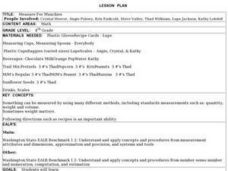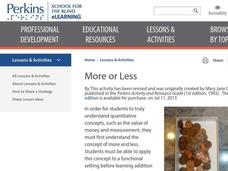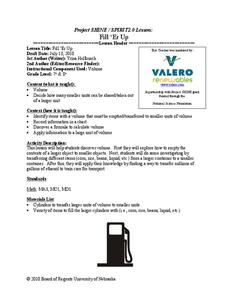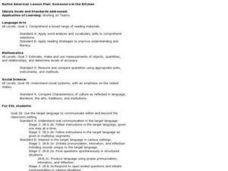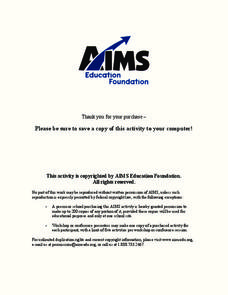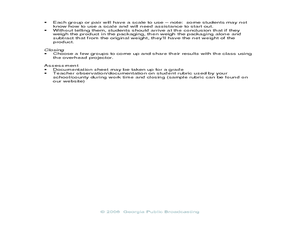NSW Department of Education
Relationships Between Formal Measurement Units: Measure and Record Mass in Kilograms and Grams
Teach the masses about the metric system with this hands-on measurement lesson. Given a fruit or vegetable, learners estimate, measure, and convert its mass using the metric units gram and kilogram.
Curated OER
Measure for Munchies
Fourth graders are introduced to the various types of measurements. Using a recipe, they practice measuring out the correct amount of ingredients while making the food. They also practice using a scale and following the directions on a...
Curated OER
The Circle's Measure
Listen to the story "Sir Cumference and the Dragon of Pi" and solve the riddle and to save Sir Cumference from the knights. Your students will love mixing an activity with story and will practice their measuring skills while...
Curated OER
Food Math
Young scholars brainstorm healthy food choices. In this health science lesson, students calculate how much of each food group they need daily. They plan a menu based on the "MyPyramid for Kids" food guide.
Curated OER
Jack and the Beanstalk: Plant a Bean and Watch It Grow
Young scholars plant bean seeds, watch them grow, and measure them with non-standard objects. They describe the bean's growth in a journal and record the growth on a calendar.
Curated OER
Weight Game
Students estimate and compare grapefruit weights. In this weight measurement and literacy lesson plan, students listen to the story Nate's Big Hair and the Grapefruit in There, then estimate the weight of a grapefruit after holding it....
Perkins School for the Blind
More or Less
The concept of more or less is one that needs to be mastered prior to learning other concepts such as quantitative analysis, addition, or subtraction. This activity provides several ways to teach learners with low or no vision to...
Curated OER
Graphic Favorite Breakfast Foods
Second graders graph data based on a class survey of their favorite breakfast foods. In this graphing lesson plan, 2nd graders take a class survey of their favorite breakfast foods. Then they take that data and put it into a computer...
Curated OER
Bell Curve
Students explore averages by completing a data analysis activity. In this bell curve lesson, students measure different food items and plot their measurements on a X and Y axis. Students create bell curves around the average weight or...
Curated OER
Someone Is In The Kitchen
Students investigate the lifestyles of the Native Americans and look at a recipe found on a website. They read the recipe and pay attention to the measurements. They differentiate between the various measures in order to apply them to...
Curated OER
Energy Forms
Learners explore energy by participating in a science lab in class. In this energy form lesson, students define the different types of energy such as light, mechanical and sound while examining energy measuring tools in class. Learners...
Utah Education Network (UEN)
Picnic Field Day
Using laminated paper cookies, get your class exploring the concept of division. Read them One Hundred Hungry Ants, by Elino R.J. Princzes, and have learners model what is happening with toy plastic ants. There are many more fun...
Curated OER
Kitchen Math For Preschoolers
Students turn kitchen time into learning time. Parents can use opportunities abound at home using "real" objects to teach beginning math. When learning begins with real objects and experiences, children use all of their senses-thus...
Curated OER
Math Medicine
Young scholars solve real-world problems related to medical careers. They use graphical representations as part of the problem-solving process and work with fractions, decimals, exponents, and metric measurement. A demonstration is...
Curated OER
Learning About Ratios: A Sandwich Study
Learners gain a concrete introduction to the concept of ratios. They demonstrate the ability to create ratios using peanut butter and jelly. They, in groups, construct 6 different sandwiches using different amounts of each food.
Curated OER
Fill 'Er Up
Middle schoolers identify how many smaller units can be found in a later unit. In this geometry lesson plan, students calculate the volume and the transfer amount to a smaller unit. They solve real life problems using the formula...
NASA
Foam Rocket
When going for distance, does it make a difference at what angle you launch the rocket? Teams of three launch foam rockets, varying the launch angle and determining how far they flew. After conducting the series of flights three times,...
Curated OER
Native American Lesson Plan: Someone's in the Kitchen
Students use vocabulary necessary to complete cooking activities and tell others about the food. They discuss similarities and differences between Native American and other nationalities' foods made in their families.
Curated OER
Learning to Use a Scale
In this scale worksheet, students measure items on a scale, and read examples. Students complete 4 questions on their own about scale measurement.
Curated OER
By Golly, By Gum
Students investigate the ingredients and creation of chewing gum. In this scientific method lesson, students make predictions about what will happen to the mass of a piece of gum as it is chewed by a human. Students graph the...
Curated OER
Prey or Pray? Could YOU Escape a Cheetah?
Tenth graders estimate the size of an adult cheetah by research and measurement of a picture. They determine the approximate distance and speed of the cheetah from a filmed chase and compare that to their own running speed.
Curated OER
Water Cycle: Weather Lesson 1
First graders go on a water walk, collect weather data, and measure rainfall for a month. They examine the water cycle in this series of lessons.
Curated OER
Tear + Net = Gross
Second graders find the net weight of a grocery item by weighing it with the tear. In this weight measurement lesson, 2nd graders bring in cans of food and watch a video about weight measurement. Students review the meanings of gross,...
Curated OER
Cornbread Addition
Fourth graders, after being given a box of cornbread mix, follow the directions to make the cornbread. They utilize measuring cups to mix all the ingredients together and incorporate adding simple fractions while mixing up the cornbread.



